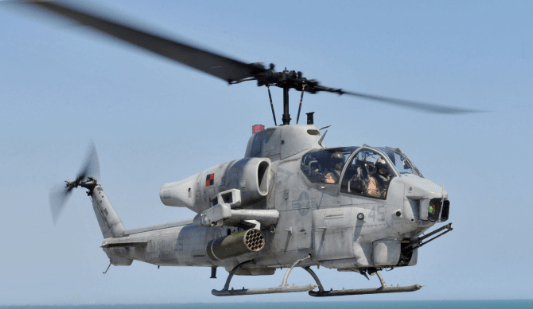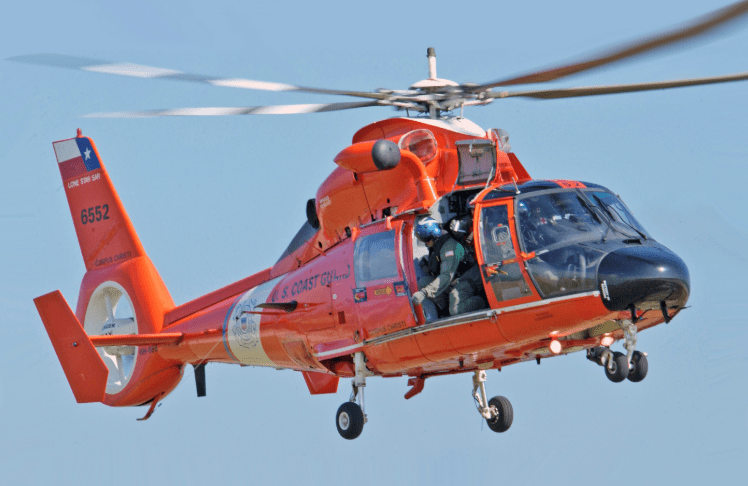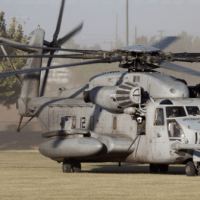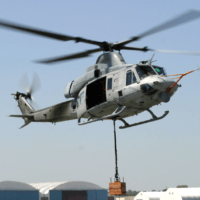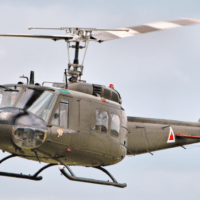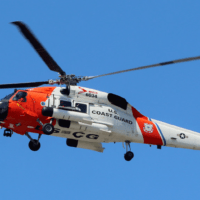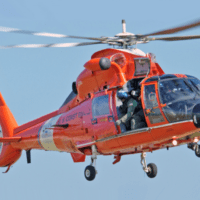New 7 Types of US Military Helicopters. After its development in the 1930s, the military helicopter became paramount during World War 2 military operations. The helicopter provided the military with unparalleled flexibility: its rotors allowing for vertical take-off and landing, and it possessed capabilities to hover and fly in all four directions.
Various category types of advanced military helicopters exist. Through the news and pop culture we hear terms like “Black Hawk” and “Chinook” helicopters.
U.S. military aerospace vehicles are designated by the Mission-Design-Series (MDS) designation system where the vehicle type symbol for helicopter is “H”. A second symbols exists for the basic mission type, such as “A” for ground attack. Further designating symbols can include the design number, series letter, status prefix, popular name, and block number.
As aviation enthusiasts, we’re going to look at the seven main category types of military helicopters, and we’ll point out some of the most widely known military helicopters for each type along the way.
1. Military Attack Helicopters
AH-1W Super Cobra
Attack helicopters’, also known as helicopter gunships, main purpose is to fire on the enemy. To achieve this purpose, attack helicopters are capable of reaching high speeds and are well-armed with an array of weaponry such as machine guns, missiles, and auto-cannons. Equipped with advanced radar for identifying enemy targets and guiding projectiles, the attack helicopter armory is used to effectively destroy enemy armed tanks and vehicles. The attack helicopter exists as a means of air support for ground troops and other aircraft.
The AH-1W Super Cobra is the Marine Corps main attack helicopter. The AH-1W Super Cobra, manufactured by Bell Helicopter, is an attack helicopter derived from the Huey design. The Super Cobra was the first attack helicopter qualifying for both the sidearm anti-radiation missile and the sidewinder air-to-air missile– it can also support hellfire missiles.
AH-1Z Viper
The Super Cobra has been operational since its fielding in 1967, and was deployed to Operation Iraqi Freedom in 2003. The Super Cobra functions as the primary attack helicopter forming the backbone of the USMC air-ground task force utilized when fire power is needed– whether providing ground cover or escorting other air support.
The Marine Corps has flown the Super Cobra since 1986 and the last of this helicopter was delivered in 1998. The AH-1W Super Cobra replaced the AH-1 Cobra, and the AH-1Z Viper replaced the Super Cobra. In 2020, the Viper is expected to replace the last Super Cobra.
2. Military Transport Helicopters
Transport helicopters are one of the larger helicopters and are designed to carry heavier loads including light vehicles, large groups of troops, and cargo into combat environments. Despite their size and load carried, transport helicopters have relatively high-speed capability.
Though cargo planes can offer the same function as a transport helicopter, the helicopter is ideal for its ability to vertically land and take off with no runway– speed is critical in battlefield operations. Transport helicopters also carry specialized equipment like rescue hoists and rope lines for dropping off and picking up troops in difficult terrain.
CH-47 Chinook
Arguably, the most widely known transport helicopter is the Chinook. The CH-47 Chinook is a twin-engine helicopter manufactured by Boeing and is often recognized by its tandem rotors. The Chinook is one of the heaviest lifting Western helicopters and is utilized as the United States Army’s primary supply and troop transport helicopter.
Boeing began developing the Chinook in 1956 and it was first fielded in Vietnam in 1962. Since the Vietnam War, the Chinook has been upgraded various times and is not expected to retire until 2060– at which point it will become the Army’s first 100-year longevity aircraft.
Sikorsky CH-53E Super Stallion
The Block 2 Chinook is the second iteration of the Chinook and includes both the CH-47 F-model and CH-47 G-model. Despite the technologically advanced capabilities of the Block 2 Chinook, the U.S. Army announced that as of Fiscal Year 20, they will no longer procure the new CH-47F and will only buy the 69 G-model Chinooks scheduled to be built. The Chinook G-model is the special operations version.
Another notable transport helicopter is the Super Stallion– known for its role in peace keeping and building international relationships. The CH-53E Super Stallion, manufactured by Sikorsky, is the largest heavy-lift transport helicopter utilized by the U.S. military. The Super Stallion was designed for use by the Marine Corps. This helicopter features a seven-bladed main rotor and can carry a whopping 73.5 K pounds of cargo.
Sikorsky CH-53E Super Stallion USMC
The U.S. Marine Corps (USMC) has used the Super Stallion since the 1980s and is projected to continue use of this helicopter through at-least 2025. Late- and post-Vietnam War era, the Air Force utilized an early iteration of the Super Stallion, the HH-53 Super Jolly Green Giant– the Super Stallion is an improved version of the HH-53.
Today, the CH-53E Super Stallion is utilized by multiple countries and is involved in numerous international military exercises– including the world’s largest international maritime training exercise. This helicopter has notably improved international relations and worldwide sea lane and ocean security.
3. Military Observation Helicopters
MH-6 Little Bird
Observation helicopters host sensor and communication equipment supporting intelligence-gathering and reconnaissance missions. These helicopters feature sensor suites, communications equipment, infrared cameras, low-light television, and laser systems utilized to observe and identify targets. Some targeting operations by observation helicopters include guiding anti-tank missiles and directing air strikes.
The MH-6 Little Bird, often called “the killer egg,” is an unmanned reconnaissance helicopter manufactured by McDonnell Douglas. Unlike many military aircraft, the Little Bird boasts the ability to be rapidly dismantled, air transported via cargo plane, and rapidly rebuilt upon arrival at destination.
The Little Bird contains many advanced digital cockpit systems including navigation, sensor, night vision, and control units. Numerous variants of the Little Bird exist including the MH-6M which has been extensively modified with avionics and mounted specialized equipment and weapons system provisions.
Originally designed for reconnaissance, in the 1980s the Little Bird was proven most effective in combat. Today, the Little Bird’s nearly exclusive use is by the U.S. Army’s elite 160th Special Operations Aviation Regiment– depositing troops, or “night stalkers,” into narrow spaces or on rooftops. The Little Bird also became widely known through the book and movie “Black Hawk Down” where the aircrafts were shown transporting Delta Force Soldiers.
Bell OH-58 Kiowa Warrior
Another stealth reconnaissance helicopter, widely utilized by military forces worldwide, is the Kiowa. The OH-58 Kiowa Warrior, manufactured by Bell Helicopter, is a four-bladed, single-engine reconnaissance helicopter featuring advanced weapons, navigation, visionics, communication, and cockpit integration systems enabling day and night operations in adverse weather conditions and standoff ranges.
Since the first Kiowa was received by the Army in 1969, this helicopter has been operational in numerous wars across many service branches including the Vietnam War, Operation Prime Chance with the U.S. Navy, RAID with the Army National Guard, in post-2001 Iraq and Afghanistan wars. In the 2013, the Aviation Restructure Initiative resulted in the U.S. Army divesting upward of 300 Kiowa helicopters through foreign military sales.
4. Military Utility Helicopters
Utility helicopters are highly versatile aircraft that excel in all environments. These helicopters can be utilized for all functions from reconnaissance or attack to transport and evacuation operations. The most iconic and notorious utility helicopter is the Black Hawk.
SIkorsky UH-60 Black Hawk US Army
The UH-60 Black Hawk, manufactured by Sikorsky, is a medium-lift, twin-engine, four-bladed utility helicopter. The Black Hawk is the U.S. Army’s tactical transport helicopter and air assault aircraft. The Black Hawk features a dragging tail wheel landing gear system. This military helicopter operates in all-weather conditions. In arctic environments, the Black Hawk can be fitted with landing skis.
The Black Hawk was first fielded by the Army in 1978 after Sikorsky’s UH-60 Black Hawk design won the United States Army Utility Tactical Transport Aircraft System (UTTAS) competition in 1976. Today, upward of 2K UH-60 Black Hawk helicopter variants are in U.S. military service. The UH-60 Blackhawk became well-known by the American public through the film “Black Hawk Down” released in 2001.
Originally, Army Regulation 70-28 dictated the naming of helicopters after Native American tribes. Said regulation no longer exists, but the tradition remains, and the Bureau of Indian Affairs is involved in the naming of new helicopters. The UH-60 Black Hawk was named in honor of the Native American War Leader, Black Hawk.
The utility helicopter “UH-1Y Venom” is known for its survivability. The UH-1Y Venom, manufactured by Bell Helicopter, is a new Marine Corps utility helicopter set to replace the Huey. The Venom is nicknamed “Super Huey” and “Yankee” acknowledging the phonetic pronunciation of its variant letter “Y.” This helicopter began fielding in 2008 replacing the Marine Corps fleet of UH-1N Twin Huey aircrafts.
Bell UH-1Y Venom
This military aircraft features two-turboshaft engines and a four-bladed, ballistically tolerant, all-composite rotor system. The Super Huey is an armed aircraft and offers greater survivability and load carrying capability, as well as a 50-percent increase in speed and range. The Super Huey is utilized for command, control, and assault support during the day and night and in adverse weather conditions.
The Iroquois, better known as the Huey, is a utility type helicopter with historical importance. The UH-1 Iroquis, known as “the Huey” and manufactured by Bell Helicopter, is a single-engine, light-lift utility helicopter with two-bladed main and tail rotors.
Bell UH-1H Huey
Capable of flight in day and night conditions, the Huey was first fielded in Vietnam as a combat-zone troop transport helicopter. In 1970, the UH-1N Iroquois entered the Air Force aircraft inventory for its search and rescue capability. Today, 16K+ of this military helicopter have been manufactured worldwide and the Huey is utilized to support wide-ranging missions including counter-narcotics operations in Afghanistan with the DEA.
5. Military Maritime Helicopters
Sikorsky MH-60R Seahawk
Maritime helicopters are newer aircraft equipped with advanced electronics and weapons systems. These helicopters were developed to support various U.S. Naval missions including search and rescue and surveillance, but their largest role is anti-submarine warfare and weapon delivery including air-launching torpedoes.
The most widely known maritime helicopter is the MH-60R Seahawk. The Seahawk, also called “Romeo” due to its designating letter “R,” is a multi-mission Naval helicopter with the primary role of an anti-submarine warfare anti-surface weapon system asset. Today, the U.S. Navy considers this maritime helicopter to be the most capable helicopter available.
6. Military Multi-Role Helicopters
A versatile type of helicopter, multi-role helicopters supporting wide-ranging missions across service branches. These helicopters are utilized when inhospitable environments and difficult terrain exists during rescue, medivac, and recovery missions.
The Apache is a multi-role helicopter widely recognizable by its dual rotors. The AH-64 Apache, manufactured by Boeing, is a twin-engine, multi-mission, heavy division attack helicopter with two four-bladed rotors (one main and one tail). The Army utilizes the Apache for precision strike and armed reconnaissance missions during day and night, and in all-weather conditions. The Apache features advanced navigation, avionics, onboard sensor suites, and systems redundancy improving survivability and lethality in combat.
Boeing AH-64 Apache
The Apache offers numerous distinguishing features including shielding between cockpits promoting survival of one or more crew members if the aircraft is hit, and the Integrated Helmet and Display Sighting System (IHADSS) where the automatic M230 Chain Gun can be mounted to the pilot or gunners’ helmet pointing in the direction they look.
This helicopter also exhibits a nose-mounted sensor suite for night-vision systems and target acquisition, and has four hardpoints mounted with a mixture of Hydra 70 rocket pods and AGM-114 Hellfire missiles, and is armed with a 30 mm (1.18 in) M230 Chain Gun. Since its conception in 1984, the U.S. Army Apache fleet has 3.9 M+ flight hours.
Relieving the Black Hawk is the Lakota: a multi-purpose helicopter heavily utilized in the Army training environment. The UH-72A Lakota, manufactured by Eurocopter, is a twin-engine, single four-bladed main rotor, single two-bladed tail rotor, light-duty helicopter utilized by the U.S. Army National Guard. The tail rotor is boxed in allowing for safe cargo loading and unloading capability.
Eurocopter UH-72A Lakota of the US Army
The Lakota is an unarmed, light-duty utility helicopter with the primary use as a medivac helicopter. As of 2006, the U.S. Army National Training Center in Fort Irwin, California began utilizing the Lakota to relieve the Black Hawk helicopters currently assigned there for medivac missions.
A favorite multi-role helicopter of the Coast Guard is the Jayhawk. The MH-60 Jayhawk, manufactured by Sikorsky, is a two-engine, medium-range, multi-mission helicopter derived from the Army’s Black Hawk helicopter.
SIkorsky MH-60 Jayhawk Coastguard
The Jayhawk is utilized by the U.S. Coast Guard for search and rescue, marine environmental protection, military readiness, law enforcement, and maritime drug interdiction missions in all-weather conditions. Notably, the Jayhawk has deployed in support of Operation Desert Storm, Operation Enduring Freedom, Alaskan hiker rescues, and Hurricane Sandy offshore rescue.
First fielded in 1990, the Jayhawk replaced the now-retired Pelican. Two variants of the Jayhawk exist including the HH-60J and MH-60T, both of which are multi-range recovery helicopters. The USCG air fleet contains 42 MH-60 Jayhawks, most of which are operational and many of which have been converted to the MH-60T since 2008.
An additional and impressive multi-purpose helicopter is the Osprey– an aircraft utilized by special operations in combat zones. The V-22 Osprey, manufactured by Boeing, is a multi-role combat aircraft. The Osprey is unique in that it takes off and lands like a helicopter, but the Osprey converts into a turbo-prop airplane during flight through the helicopter’s tilt rotor technology.
Bell Boeing V-22 Osprey
Iterations of the Osprey are utilized by the United States Marine Corps and the United States Air Force for special operations missions. With its unique capability, the Osprey has deployed in medivac and transport operations in combat-zones across the Middle East.
Finally, the Sea King is among the most notable multi-purpose helicopters for its active role of transporting the U.S. president. The SH-3 Sea King, manufactured by Sikorsky, is a twin-engine helicopter featuring a boat-like frame atop pontoons with floating bags allowing it to make a water landing.
The Sea King was the first amphibious helicopter worldwide and the first of its kind for use by the U.S. military. The Sea King’s primary use was for anti-submarine warfare by the U.S. Navy.
From its first use in 1961 through its replacement in the 1990s, the Sea King was a key anti-submarine warfare asset by the U.S. Navy. More than 52-years after its first flight, today the Sea King is no longer in production, but it continues to serve Marine One flying the President of the United States.
7. Military Search and Rescue Helicopters
Eurocopter MH-65 Dolphin
The last type of helicopter we’re going to look at today are search & rescue helicopters. To achieve this, search and rescue helicopters are equipped with advanced avionics and radar systems.
The Coast Guard’s primary search and rescue helicopter is the Dolphin. The MH-65 Dolphin, manufactured by Eurocopter, is a two-engine, short-range recovery helicopter operated by and easily identified as a U.S. Coast Guard helicopter due to its orange color. The Dolphin operates during day and night and in all weather conditions except during icing.
Today, the Dolphin is the Coast Guard’s primary search and rescue helicopter. This helicopter is expected to operate through 2027.
The MH-65 recently underwent significant upgrades including addressing obsolete components and upgrading the communications package through a conversion-sustainment initiative. Notably, since 2007, the Coast Guard’s Dolphin fleet received engine upgrades adding 40-percent more airborne use of force and power capabilities.
That all article about New 7 Types of US Military Helicopters, for image details please look at the gallery below…
